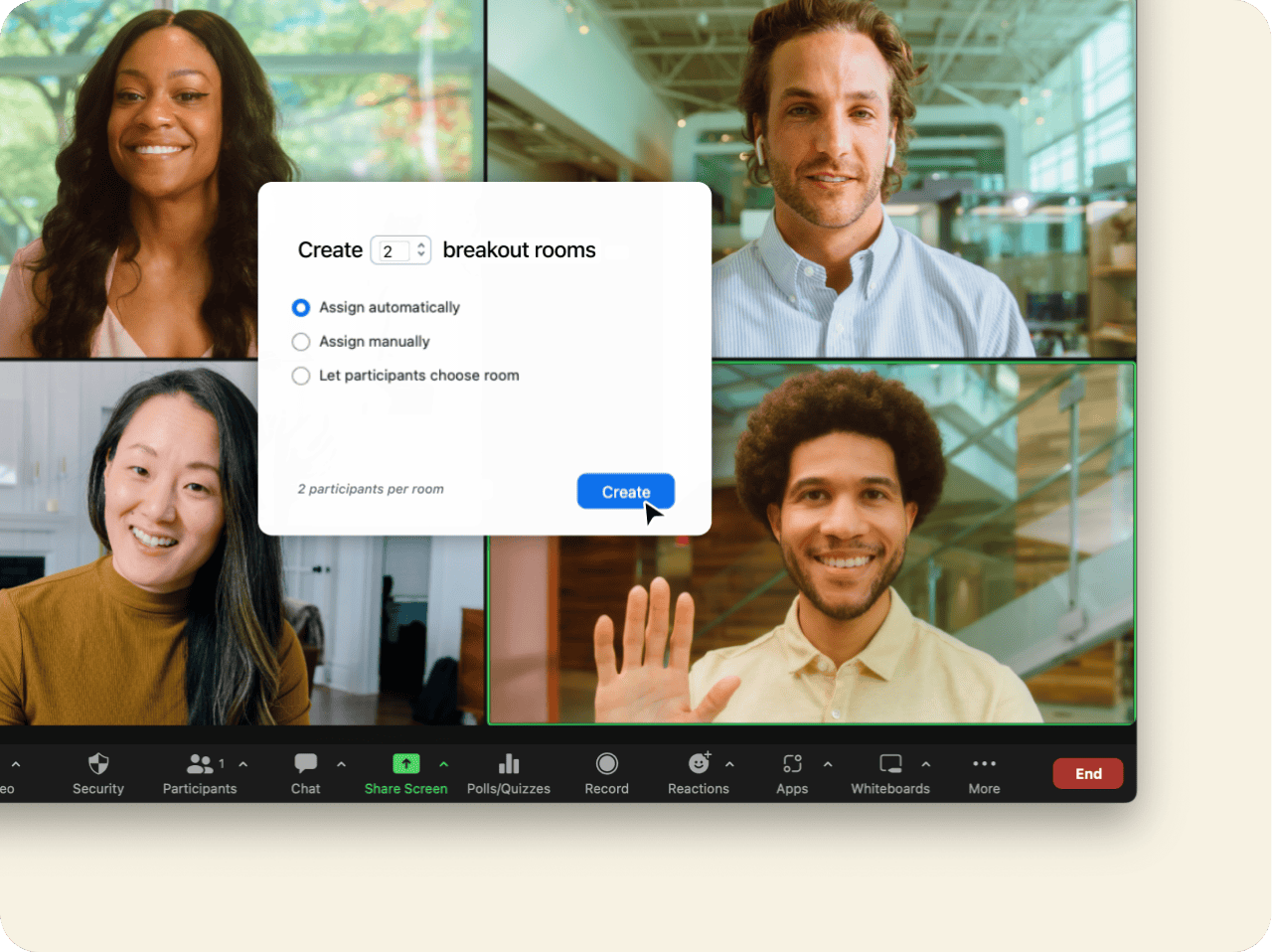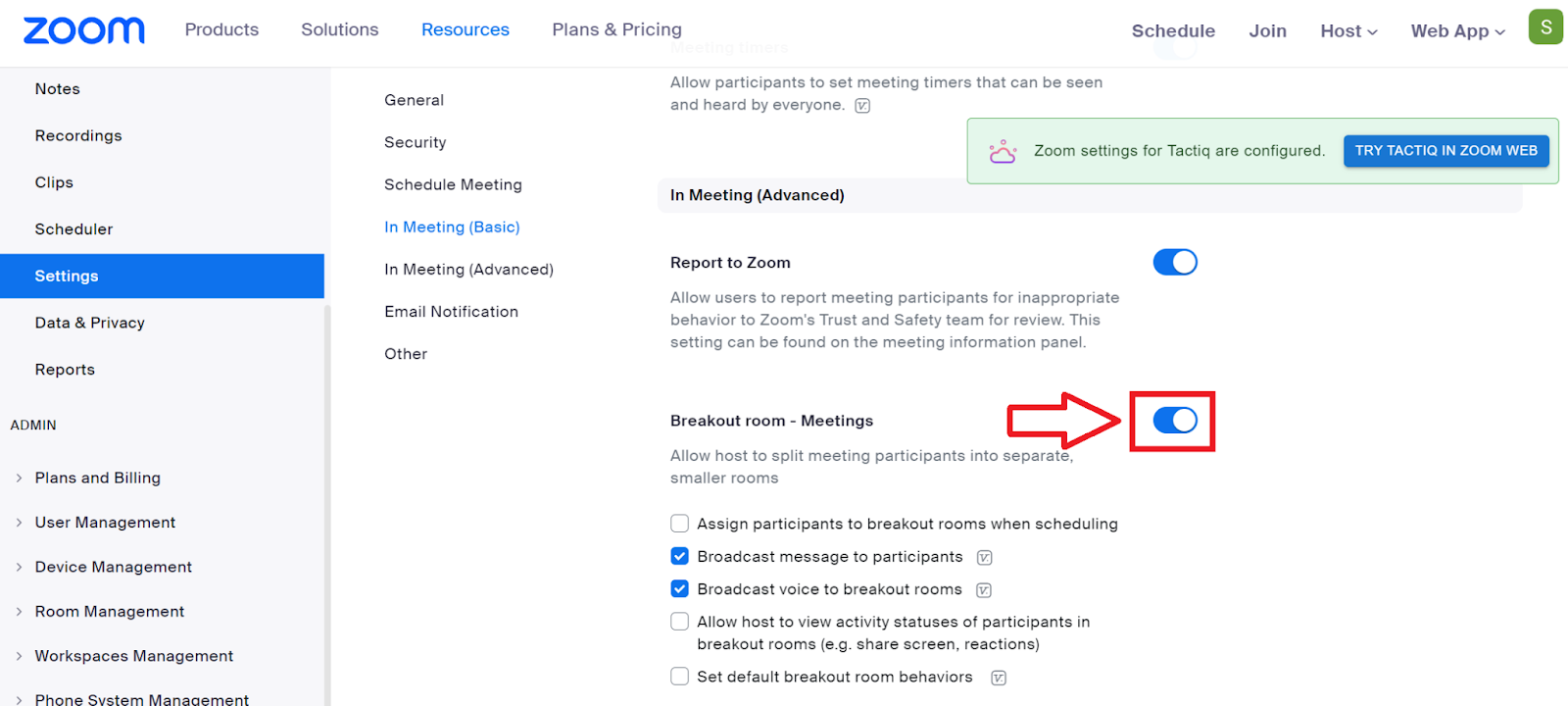How to Use Breakout Rooms in Zoom for Meetings
August 1, 2024
August 1, 2024
June 12, 2025
June 12, 2025
Zoom's breakout room feature facilitates focused and engaging discussions in your meetings. Using breakout rooms can be a key factor in creating the perfect meeting environment.
This article explores what breakout rooms are, their functionalities, and the various scenarios where they can be most beneficial.
What are Zoom Breakout Rooms?

Image from Zoom
Zoom breakout rooms let you split your main meeting into smaller sessions. These smaller rooms allow participants to have focused discussions without leaving the main meeting. They help in creating a more engaging and collaborative environment.
Definition and Basic Functionality
Breakout rooms in Zoom allow the meeting host to divide a Zoom meeting into separate, smaller sessions. Participants in these rooms can use video, audio, and chat just like in the main meeting. The host can switch between breakout rooms to check in on different groups.
Common Scenarios for Breakout Room Usage
Breakout rooms can be useful in various situations:
- Team Building Activities: Split participants into groups for icebreakers or team challenges.
- Training Sessions: Trainers can provide personalized attention to smaller groups.
- Client Meetings: Separate rooms for client discussions and internal team debriefs.
Using breakout rooms effectively can transform your Zoom meetings into more dynamic and engaging sessions.
Why Use Breakout Rooms in Zoom Meetings?
Breakout rooms in Zoom meetings offer several key benefits that enhance the overall experience. They are especially useful in promoting active participation, ensuring focused discussions, and managing large groups effectively. Here’s a closer look at why you should consider using breakout rooms:
Enhanced Collaboration and Engagement
Breakout rooms encourage everyone to contribute, as the smaller group size makes it easier for individuals to voice their opinions and ideas.
- Active Participation: Smaller groups mean more opportunities for each person to speak.
- Peer Learning: Participants can learn from each other through close interaction.
- Dynamic Discussions: Breakout rooms can lead to more lively and varied conversations.
Facilitating Small Group Discussions and Activities
Breakout rooms are perfect for small group discussions and activities. They provide a space where participants can dive deeper into specific topics without the distractions of a larger group setting.
- Focused Activities: Small groups can work on targeted tasks or projects.
- Interactive Exercises: Breakout rooms are ideal for role-playing, brainstorming, or collaborative problem-solving activities.
- Personalized Attention: Facilitators can give more individualized feedback and support.
Improving Participant Focus and Interaction
In large meetings, it’s easy for participants to lose focus. Breakout rooms help mitigate this by creating a more engaging and interactive environment.
- Direct Interaction: Participants can interact directly with each other and the host.
- Reduced Distractions: Smaller groups minimize background noise and off-topic conversations.
- Increased Accountability: Participants are more likely to stay engaged and accountable in a smaller group.
Effective Management of Large Meetings and Workshops
Managing a large meeting or workshop can be challenging. Breakout rooms streamline this process, making it easier to handle different segments of the meeting efficiently.
- Organized Structure: Breakout rooms allow you to organize participants into manageable groups.
- Time Management: Hosts can set timers for each breakout session, ensuring that discussions stay on track.
- Flexibility: Breakout rooms can be opened and closed as needed, allowing for seamless transitions between group discussions and the main meeting.
Using breakout rooms in Zoom meetings improves focus and interaction, making it an effective tool for managing large meetings and workshops.
How to Enable Breakout Rooms in Zoom
To use breakout rooms in Zoom, you must first enable them in your account settings. Here’s a step-by-step guide to get you started:
- Sign In: Log in to your Zoom account via the web portal.
- Access Settings: Navigate to the “Settings” menu on the left side of the screen.
- Meeting Settings: Under the “Meeting” tab, scroll down to the “In Meeting (Advanced)” section.
- Enable Breakout Rooms: Toggle the switch next to “Breakout Room” to turn this feature on.

- Save Changes: Click “Save” to apply your settings.
Customizing Breakout Room Settings
Once you’ve enabled breakout rooms, you can customize various settings to meet your needs.
- Allow Host to Assign Participants: Enable the option that lets hosts assign participants to breakout rooms when scheduling a meeting.
- Timer Settings: Set a timer for each breakout session to ensure discussions stay within the allotted time.
- Return to Main Session: Allow participants to return to the main session at any time, giving them the flexibility to leave their breakout room if needed.
- Countdown Timer: Use a countdown timer to notify participants when their breakout session is about to end.
Pre-Assigning Participants to Breakout Rooms
Pre-assigning participants can save time and ensure that the right people are grouped together.
- Schedule a Meeting: Go to the “Meetings” menu and click “Schedule a Meeting.”
- Meeting Options: Scroll down to the “Options” section and check the box next to “Breakout Room pre-assign.”
- Create Rooms: Click on “+ Create Rooms” to add breakout rooms.
- Assign Participants: Enter the email addresses or names of participants you want to pre-assign to each room.
- Save Assignments: Click “Save” to finalize your breakout room assignments.
Managing Breakout Rooms During the Meeting
Managing breakout rooms during a meeting involves several key actions to ensure everything runs smoothly.
- Open All Rooms: Once your meeting starts, click on the “Breakout Rooms” button and then “Open All Rooms” to begin the breakout sessions.
- Move Participants: You can move participants between rooms if needed by clicking on their name and selecting the room you want to move them to.
- Broadcast Messages: Use the “Broadcast a Message to All” feature to send a message to all breakout rooms simultaneously.
- Close Rooms: When the discussion time is up, click “Close All Rooms.” Participants will receive a notification and have 60 seconds to return to the main session.
Enabling and customizing breakout rooms in Zoom is a powerful way to enhance your meetings. By following these steps, you can create a more engaging and organized virtual meeting environment.
How to Create and Manage Breakout Rooms in Zoom
Creating Breakout Rooms
Creating breakout rooms during a meeting allows you to split participants into smaller groups for focused discussions or activities. Here’s how you can create breakout rooms:
- Start Your Meeting: Begin by starting your scheduled Zoom meeting.
- Open Breakout Rooms Menu: Click “More” in the meeting toolbar then select “Breakout Rooms.” This opens a new window where you can set up the rooms.
- Select Number of Rooms: Choose how many breakout rooms you need. You can create up to 50 rooms on most Zoom plans.

- Assign Participants: You have two options:
- Automatic Assignment: Zoom will randomly distribute participants evenly across the rooms.
- Manual Assignment: You can manually select which participants go into each room.
Managing Breakout Rooms
Managing breakout rooms effectively ensures that your meeting runs smoothly and that participants stay engaged.
How to Move Participants Between Rooms
- Open Breakout Rooms Management: Click “More” in the meeting toolbar then select “Breakout Rooms”.
- Select Participant: Find the participant you want to move. Hover over their name.
- Move Participant: Click the “Move to” option and select the new room from the dropdown menu.
Broadcasting Messages to All Rooms
- Open Breakout Rooms Management: Click “More” then “Breakout Rooms”.
- Broadcast a Message: Click “Broadcast message” at the bottom of the breakout rooms window.
- Type Message: Enter your message in the text box and click “Broadcast.”
Closing and Reopening Breakout Rooms
- Close All Rooms: When it’s time to end the breakout sessions, click “Close All Rooms.” Participants will get a 60-second countdown to wrap up their discussions.
- Reopen Rooms: If you need to send participants back into breakout rooms, click “Open All Rooms” again. Previous room assignments will be remembered unless you’ve made changes.
Creating and managing breakout rooms in Zoom is an effective way to facilitate small group interactions, enhance collaboration, and keep participants engaged. By following these steps, you can ensure that your Zoom meetings are productive and organized.
Tips for Effective Breakout Room Sessions
Setting Clear Objectives and Instructions for Participants
Having clear objectives is crucial for the success of your breakout sessions.
- Define Goals: Before the meeting, decide what you want each group to achieve. This could be solving a problem, discussing a topic, or brainstorming ideas.
- Communicate Clearly: At the beginning of the session, explain these goals to your participants. Use simple language and make sure everyone understands what is expected.
- Provide Written Instructions: Share the objectives and instructions in the chat or through a document. This helps participants refer back to them if needed.
Assigning Roles and Responsibilities Within Rooms
Assigning specific roles can make breakout rooms more organized and efficient.
- Role Assignment: Assign roles such as a leader, note-taker, and timekeeper. The leader facilitates the discussion, the note-taker records key points, and the timekeeper ensures the group stays on track.
- Explain Roles: Briefly explain what each role entails. This can be done before participants enter their breakout rooms.
- Rotate Roles: For recurring meetings, rotate roles among participants. This ensures everyone gets a chance to develop different skills.
Providing Necessary Resources and Materials
Ensure that participants have all the resources they need to succeed in their breakout rooms.
- Prepare Materials: Gather any documents, links, or resources participants will need during the session.
- Share Resources: Distribute these materials before the breakout sessions start. You can use the chat feature or share a link to a shared folder.
- Accessibility: Make sure all resources are easily accessible and can be opened by all participants.
Monitoring and Assisting Breakout Rooms as a Host
As a meeting host, your role is to monitor and assist breakout rooms to ensure everything runs smoothly.
- Join Rooms: Periodically join breakout rooms to check on progress and address any questions. This shows participants that you are available and supportive.
- Use “Ask for Help”: Inform participants about the “Ask for Help” button, which they can use to request your presence in their room.
- Broadcast Updates: Use the broadcast message feature to send updates or reminders to all rooms. This can be useful for time checks or to share important information.
- Collect Feedback: After the breakout sessions, collect feedback from participants to understand what worked well and what could be improved.
Following these tips will help you run effective and engaging breakout room sessions in Zoom. By setting clear objectives, assigning roles, providing necessary resources, and actively monitoring the rooms, you can ensure a productive and smooth experience for all participants.
{{rt_cta_ai-convenience}}
How Tactiq Enhances Breakout Room Experiences

AI tools like Tactiq make your Zoom breakout room sessions more effective. Here’s how Tactiq can improve your breakout room experiences:
Why Use Tactiq for Breakout Rooms?
- Live Transcriptions for Accurate Note-Taking: Real-time capture of everything said in breakout rooms, allowing participants to focus on discussions.
- AI-Generated Summaries of Discussions: Quick understanding of key points without sifting through lengthy transcripts.
- Ensuring No Key Insights Are Missed: Comprehensive capture of discussions ensures informed follow-up actions.
How Tactiq Helps with Post-Breakout Room Actions
- Automating Synthesis of Meeting Notes: Synthesizes all transcriptions into cohesive notes, ensuring all important points are captured without bias.
- Generating Actionable Insights and Follow-Up Tasks: Identifies key decisions and outlines next steps, making it easier to move forward.
- Reducing Manual Effort for Post-Meeting Consolidation: Provides a consolidated view of all breakout room discussions, simplifying the review process.
Tactiq enhances breakout room experiences by ensuring accurate capture of discussions, streamlining post-meeting actions, and allowing facilitators to focus on strategic activities rather than administrative tasks.
Zoom breakout rooms let you split your main meeting into smaller, focused sessions where participants can discuss topics in depth. This setup boosts engagement and collaboration, so you get more dynamic and productive meetings.
You enable breakout rooms by logging into your Zoom web portal, navigating to Settings, and toggling on the Breakout Room feature under 'In Meeting (Advanced)'. You can then customize options like assigning participants, setting timers, and allowing participants to return to the main session, giving you full control over group dynamics.
Set clear objectives, assign roles like leader or note-taker, and provide all necessary resources before starting. By doing this, you keep participants focused and ensure every group stays organized and productive.
You can open or close rooms, move participants between groups, and broadcast messages to all rooms from the Breakout Rooms menu. These tools help you keep discussions on track and make sure everyone stays informed and engaged.
Tactiq provides live transcriptions and AI-generated summaries for every breakout room, so you never miss key insights. You save time on manual note-taking and get actionable meeting notes and follow-up tasks, allowing you to focus on meaningful discussions and next steps.
Want the convenience of AI summaries?
Try Tactiq for your upcoming meeting.
Want the convenience of AI summaries?
Try Tactiq for your upcoming meeting.
Want the convenience of AI summaries?
Try Tactiq for your upcoming meeting.









